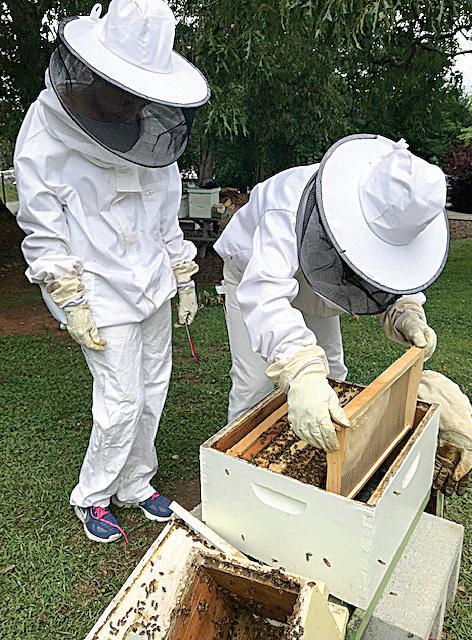
5 minute read
Gardening
The Environmental Gardener
Erica Glasener
Advertisement
is the Community Involvement and Events Manager for the Piedmont Park Conservancy. She also serves on the advisory board for Trees Atlanta.
Summer is almost over. I don’t know about you, but I am still trying to keep up with the weeds in my garden. With all the rain we’ve had, it’s been a challenge.
The good news is that there is still time. If we’re lucky we’ll get at least a few cooler days in September, perfect for weeding, cutting back and dividing perennials, preparing beds for new plants, starting seeds for fall vegetable crops and generally tidying up the garden.
Tips for dividing perennials
As a rule of thumb, divide perennials when they are not blooming. In the fall, divide them early enough during the season so that they will have four weeks to establish new roots before a hard frost.
Whether you use a digging spade or fork or two shovels back-to-back, dig up a large clump with lots of roots and then divide the clump, making sure each section has plenty of roots and shoots. (For the best results use clean, sharp tools.)
Minimize transplant shock by cutting the foliage back by 1/3 to 1/2 at the time you transplant. This will help compensate for root loss.
Prepare the new planting area ahead of time so that roots of the divisions won’t dry out. Water new transplants immediately after you plant them and then once a week until the ground freezes, if there is no rain. Apply two gallons of water for each one-gallon size perennial. Resume watering in early spring once every few weeks.
Apply one to two inches of mulch around divisions after transplanting.
Make a map, it can be a sketch, labeling the new plants you add to your garden or share with fellow gardeners.
Some perennials should be divided by hand, not with a sharp spade or digging fork, but by digging up a large clump and then teasing apart the roots, making sure shoots are attached to each section.
You can use two pitchforks back-to-back, or a pitchfork (or digging fork) and a spade to pull apart the root balls. Try this method with the following plants: Black-eyed Susans; Bluestar; Blue Indigo; Coralbells; Daylilies; Garden Phlox; Irises.
Do not divide ornamental grasses in the fall. Wait until early spring and divide them as soon as new growth begins to emerge.
Plant cool-season vegetable seeds and seedlings
Prepare the soil by adding organic soil amendments. Ideally, you want to mix them in to a depth of 12 inches but even 5 to 6 inches will make a difference.
Plant your seeds a bit deeper than you would in the spring when soils are cooler. This way they shouldn’t dry out as quickly while they are germinating. Be sure to soak the soil after planting. Keep up with watering during the hot weather, watering once a week, making sure to saturate the soil.
Crops to consider for fall: beets; broccoli;



45 IVAN ALLEN JR BOULEVARD NW #2605
offered for $685,000 | JUST LISTED 1155 BRIARCLIFF PLACE NE
offered for $925,000 | JUST LISTED

Rodney Hinote
REALTOR®
c: 404.786.9562 o: 404.480.HOME RODNEY@ANSLEYRE.COM RODNEYHINOTE.COM


cabbage; collards; garlic; onion sets (small bulbs); parsley (transplants will reward you all winter); spinach; radishes.
Tips on planting
Before you plant, clean up your garden. Cut back perennials and weed. Pull weeds before they flower and set seed. This will result in fewer weeds next spring.
Make sure, too, to remove dead leaves Shrubs and trees to consider
Here are a few plants to consider adding to your garden this fall. The ones marked with an asterisk (*) are choice trees for small gardens
Beautyberry- Callicarpa americana
- A deciduous shrub with brilliant purple or magenta fruits that appear in autumn on arching stems, growing 3 to 5 feet and sometimes even 9 feet. Easy to grow, this beauty thrives in full sun or part shade. The seeds and berries are a favorite of birds and deer. *Dogwood-Cornus florida, our native flowering dogwood is a favorite of many for its lovely white blooms in spring as well as its red fruits and sometimes scarlet red foliage in fall. It grows 20-40’ tall and is favored by native bees.
*American Fringe tree- Chionanthus
virginicus is also called Grancy Greybeard for its white lightly fragrant flowers which look almost like a beard. It reaches 12-30’ tall and bursts into bloom usually in April. Plant one or several.
*Sourwood-Oxydendrum arboreum
is a deciduous tree that grows 20-25’ tall. It’s fragrant flowers in summer attract bees and Sourwood honey is a favorite. The leaves turn shades of red and crimson in autumn. A great understory tree.







Molly Carter Gaines

MY RECENT ACTIVITY
Sold Under Contract Under Contract
1020 BELLEVUE DRIVE NE offered for $2,251,000
Sold
1242 MAYFAIR offered for $1,100,000
Sold
877 HIGHLAND TERRACE NE offered for $1,795,000
323 4TH AVENUE offered for $999,000 739 OAKLAND AVENUE SE offered for $760,000 696 ARCOS WAY SE offered for $437,125










